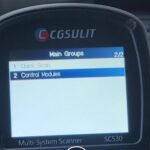Experiencing issues with your Honda Accord 2017 failing a smog test due to incomplete readiness monitors? Understanding the OBD2 system and performing a proper drive cycle is often the key to resolving this. This guide, based on standard OBD-II procedures, will help you understand how to get your 2017 Honda Accord’s readiness monitors in check.
The OBD-II drive cycle is a sequence of driving conditions designed to allow your vehicle’s onboard diagnostic system to run all of its emissions monitors. These monitors need to be in a “ready” state to pass a smog test. The drive cycle should begin with a cold start – meaning the engine coolant temperature should be below 122 degrees Fahrenheit (50 degrees Celsius) and close to the ambient air temperature. It’s important that the ignition is not turned on before the cold start, as this can prevent the heated oxygen sensor diagnostic from running correctly.
Here’s a step-by-step guide to performing an OBD-II drive cycle in your Honda Accord 2017:
-
Initial Idle: Start your Honda Accord 2017 and let it idle in drive for two and a half minutes. Ensure the air conditioning (A/C) and rear defroster are turned on during this step. This allows the OBD-II system to check the oxygen sensor heater circuits, air pump, and EVAP purge system.
-
Moderate Acceleration and Steady Speed: Turn off the A/C and rear defroster. Accelerate smoothly to 55 mph (88 km/h) using about half throttle. Maintain a steady speed of 55 mph for three minutes. During this phase, the OBD-II system checks for ignition misfires, fuel trim, and canister purge, and monitors components like the EGR, air pump, O2 sensors, and canister purge.
-
Deceleration: Coast down to 20 mph (32 km/h) without using the brakes or clutch. This step allows the OBD-II system to check the EGR and purge functions during deceleration.
-
Re-acceleration and Steady Speed: Accelerate again to 55 to 60 mph (88-96 km/h) using half throttle. Maintain this steady speed for five minutes. This stage allows the OBD-II to monitor catalytic converter efficiency, misfires, EGR, fuel trim, oxygen sensors, and purge functions under consistent driving conditions.
-
Final Deceleration and Stop: Coast down to a complete stop without braking. This final deceleration allows the OBD-II system to perform a last check of the EGR and canister purge systems.
After completing this drive cycle, the readiness monitors in your Honda Accord 2017 should ideally be set. You can then use an OBD2 scanner, plugged into your Honda Accord 2017 Obd2 Port, to verify the status of your readiness monitors before attempting a smog test again. The OBD2 port in your Honda Accord 2017 is typically located under the dashboard on the driver’s side. Consult your owner’s manual for the precise location if needed.
Keep in mind that while this drive cycle is generally effective, some monitors may require multiple drive cycles to complete, and specific conditions might vary slightly depending on your Honda Accord 2017’s model year and specific engine configuration. If you continue to experience issues, it’s recommended to consult a qualified mechanic to diagnose any underlying problems that may be preventing your readiness monitors from setting.
